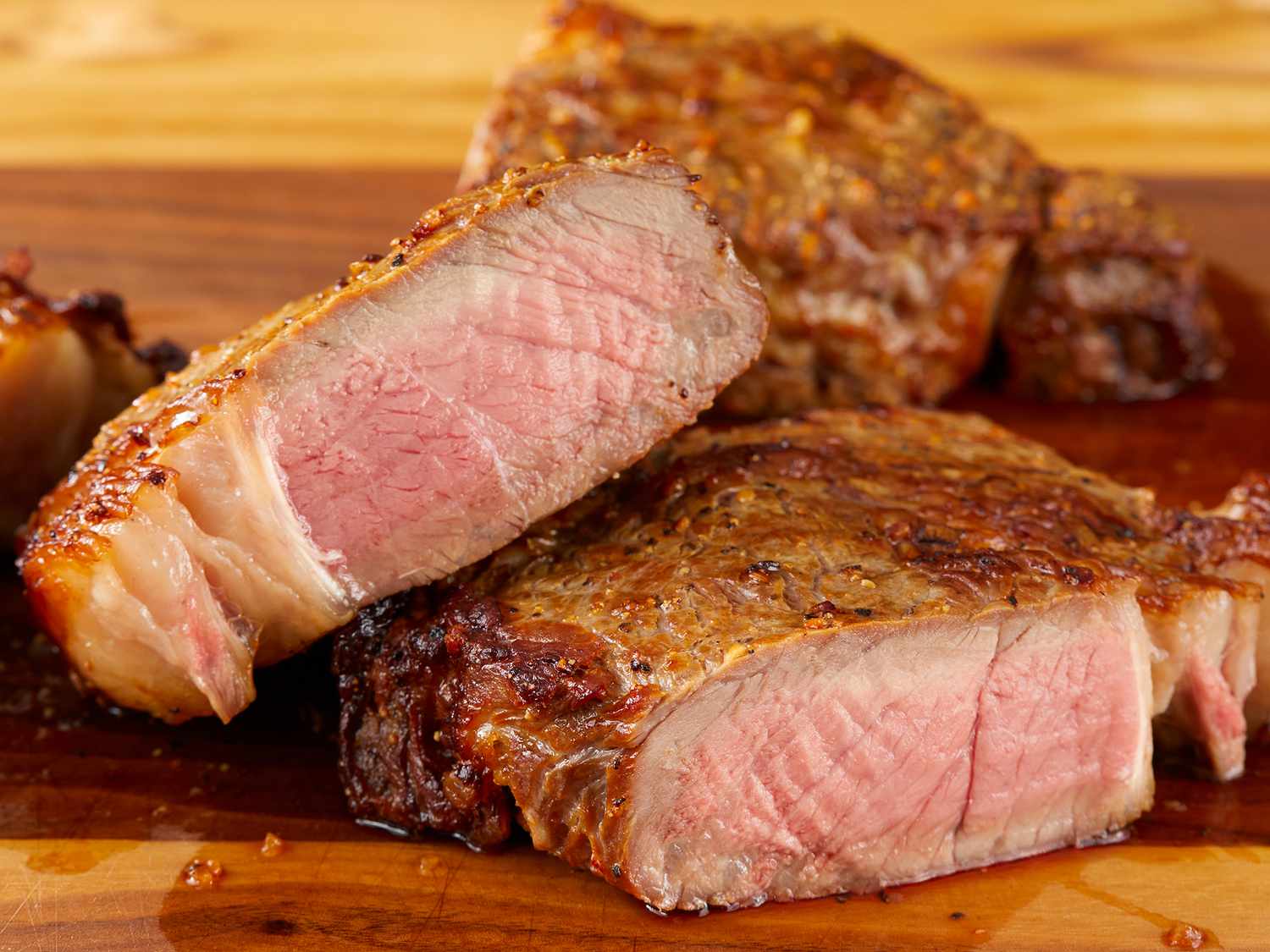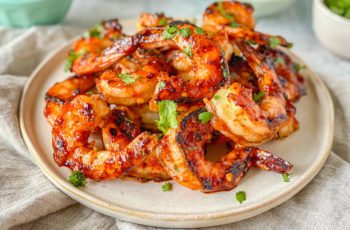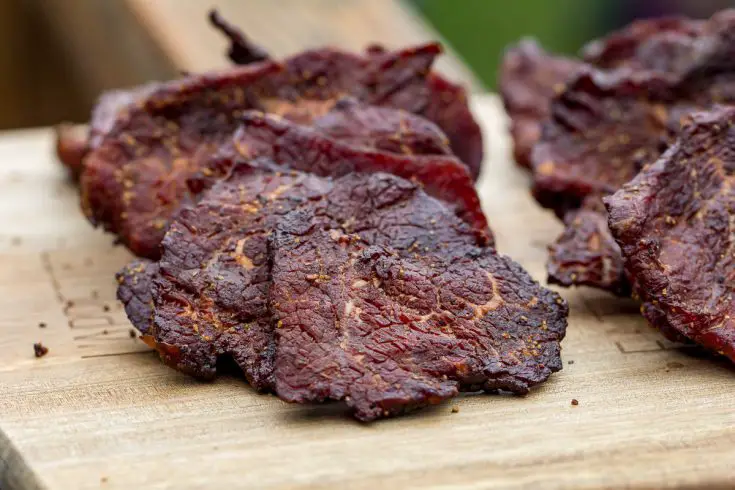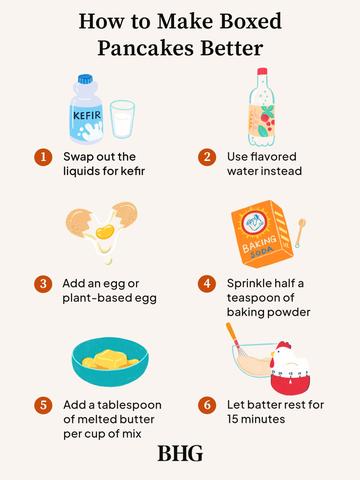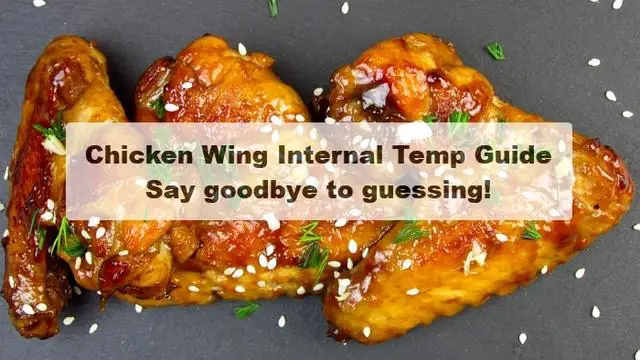
“Discover the Perfect Temperature for Wrapping Pork Butt: Unveiling the Optimal Technique to Achieve Tender and Flavorful Results!”
IS WRAPPING PORK BUTT NECESSARY?
Yes, wrapping the pork butt is necessary for the cooking process. Wrapping the meat helps manage the stall, which occurs when the meat’s temperature reaches between 150 and 175F and it begins evaporating liquid. The wrap helps the meat get through the stall and reduces evaporation, resulting in a juicy texture from the inside and a crispy texture from the outside.
Wrapping also protects the meat, ensuring even distribution of heat throughout and preventing the bark from drying out. It retains moisture inside the meat, creating a humid environment that prevents drying as it cooks. Additionally, wrapping speeds up the cooking process by retaining heat and allowing for faster, more even cooking.

PROTECTING THE MEAT FROM SMOKE AND HEAT
When smoking pork butt, it is important to protect the meat from excessive smoke and heat. Wrapping the pork shoulder in foil or kraft paper helps create a barrier that prevents the meat from drying out and ensures even distribution of heat. This method also helps retain moisture and flavor, making the final product juicy and tender.
One of the main reasons for wrapping pork butt is to prevent the stall, which occurs when the meat’s temperature reaches between 150 and 175F. During this stage, the meat begins to evaporate liquid, causing a drop in temperature. By wrapping the pork shoulder, you can help it get through the stall more quickly and maintain its juiciness.
Wrapping the pork butt not only protects it from drying out but also helps retain moisture inside the meat. The humid environment created by wrapping ensures that the meat stays moist during the long smoking process. Additionally, any drippings of fat that come out of the meat will be retained, adding flavor and juiciness to the final result.
If you’re looking to speed up the cooking process, wrapping the pork shoulder can help retain heat and ensure even cooking. By increasing the temperature after wrapping, you can expedite cooking time without sacrificing tenderness or flavor.
Knowing when to wrap pork shoulder is crucial for achieving perfect texture. As a general rule of thumb, wrap the pork shoulder when its internal temperature reaches between 155 and 170F and when you’re satisfied with the bark’s appearance. However, factors such as size and cooking method may influence when to wrap, so it’s important to monitor temperature and bark development.
There are two common methods for wrapping pork shoulder: using aluminum foil or kraft paper. To wrap in foil, place the pork shoulder on a sheet of heavy-duty foil and wrap it tightly without crushing the meat. Alternatively, spread a large piece of kraft paper on a table, position the pork shoulder with the fat side down in the middle, and fold the edges over to completely wrap the meat.
After removing the wrapped pork shoulder from the smoker, it’s crucial to let it rest for at least two hours. This allows the juices to redistribute within the meat, resulting in a tender and flavorful final product. Once rested, simply unwrap and shred the meat using a fork or shredding claw.
Remember, these guidelines serve as a general reference point, but individual cooking times may vary depending on factors such as size and desired doneness. Always use a thermometer to ensure accurate temperature readings throughout the cooking process.
RETAINING MOISTURE
Wrapping the pork butt helps retain moisture inside the meat during the smoking process. The wrap creates a humid environment that prevents the meat from drying out as it cooks. This is crucial for achieving juicy and flavorful pulled pork.
Furthermore, wrapping the pork butt also helps retain any drippings of fat that come out of the meat. These drippings contribute to the overall flavor and juiciness of the meat. By trapping them inside the wrap, you ensure that they are absorbed back into the meat, resulting in a more flavorful end product.
Retaining moisture is essential for achieving tender and succulent pulled pork. It ensures that the meat remains moist throughout the long smoking process, resulting in a melt-in-your-mouth texture that everyone will love.
SPEEDING UP SMOKING PROCESS
If you want to shorten the smoking process for the pork shoulder, there are a few techniques you can use. First, make sure to wrap the pork shoulder tightly in foil or kraft paper. This will help retain heat and cook the meat faster. Additionally, you can increase the temperature of your smoker after wrapping the pork shoulder to speed up cooking time. Keep in mind that higher temperatures may result in a less tender meat, so find a balance that works for you. Finally, using boneless pork shoulder instead of bone-in can also reduce cooking time.
WHEN SHOULD YOU WRAP PORK SHOULDER?
Knowing when to wrap the pork shoulder is crucial to achieving the perfect texture and flavor. The general rule of thumb is to wrap the pork shoulder when it reaches a temperature between 155 and 170F and when the bark is cooked to your preference. Wrapping the pork shoulder at this stage helps prevent the stall, ensuring that the meat stays juicy and tender.
However, several factors can affect when you should wrap the pork shoulder, including its size and how you are cooking it. It’s important to check the temperature and bark of the meat for signs that it is ready to be wrapped. This will help you make an informed decision about when to wrap the pork shoulder.
WHEN SHOULD YOU TAKE THE PORK SHOULDER OUT OF THE WRAP?
Knowing when to take the pork shoulder out of the wrap is crucial to achieving the perfect texture and flavor. The general rule of thumb is to remove the pork shoulder from the wrap when it reaches a temperature between 190 and 195F. However, keep in mind that the meat will continue to cook for a bit after being removed from the heat, so allow for a small rise in temperature. It is also important to let the meat rest inside the wrap for at least two hours before serving. This allows the juices to be reabsorbed into the meat, resulting in a tender and flavorful final product.
THE PROCESS OF WRAPPING PORK SHOULDER
Wrapping the pork shoulder is an essential step in the cooking process to achieve the perfect texture and flavor. There are two methods you can follow: using aluminum foil or kraft paper.
If you choose to use aluminum foil, place the pork shoulder in a sheet of heavy-duty foil. Make sure it is large enough to completely wrap the meat. Wrap it tightly, but not too tight to crush the pork, to prevent moisture from escaping.
Alternatively, you can use kraft paper. Spread a large piece of kraft paper on a table and place the pork shoulder in the middle with the fat side facing down. Fold the edges of the paper over the pork shoulder, ensuring that every side of the meat is wrapped.
WRAPPING IN ALUMINUM FOIL
Wrapping the pork shoulder in aluminum foil is a popular method for ensuring a moist and tender result. To wrap the pork shoulder in foil, start by placing it in the center of a sheet of heavy-duty foil. The foil should be large enough to completely wrap the pork shoulder. Next, tightly wrap the foil around the meat, making sure to seal it well to prevent any moisture from escaping. Be careful not to wrap it too tight, as this can crush the pork.
Another option for wrapping the pork shoulder is to use kraft paper. This method can help create a flavorful and juicy result. To wrap the pork shoulder in kraft paper, begin by spreading a large piece of kraft paper on a table or other flat surface. Place the pork shoulder in the middle of the paper with the fat side facing down. Fold the edges of the paper over the pork shoulder, ensuring that every side of the meat is wrapped securely. This will help protect and retain moisture during cooking.
WRAPPING IN KRAFT PAPER
Wrapping the pork shoulder in kraft paper is another option for achieving a flavorful and tender result. Follow these steps to wrap the pork shoulder in kraft paper:
- Use a large piece of kraft paper and spread it on a table.
- Place the pork shoulder in the middle of the kraft paper with the fat side facing down.
- Start folding the edges of the kraft paper over the pork shoulder, ensuring that every side of the meat is wrapped securely.
- Fold and tuck in any excess paper to create a tight seal around the pork shoulder.
Wrapping the pork shoulder in kraft paper helps retain moisture, protects the meat, and adds flavor during cooking. It also allows for even heat distribution and helps create a juicy and tender final product.
A GUIDE TO PREPARING THE PORK SHOULDER FOR YOUR SMOKER
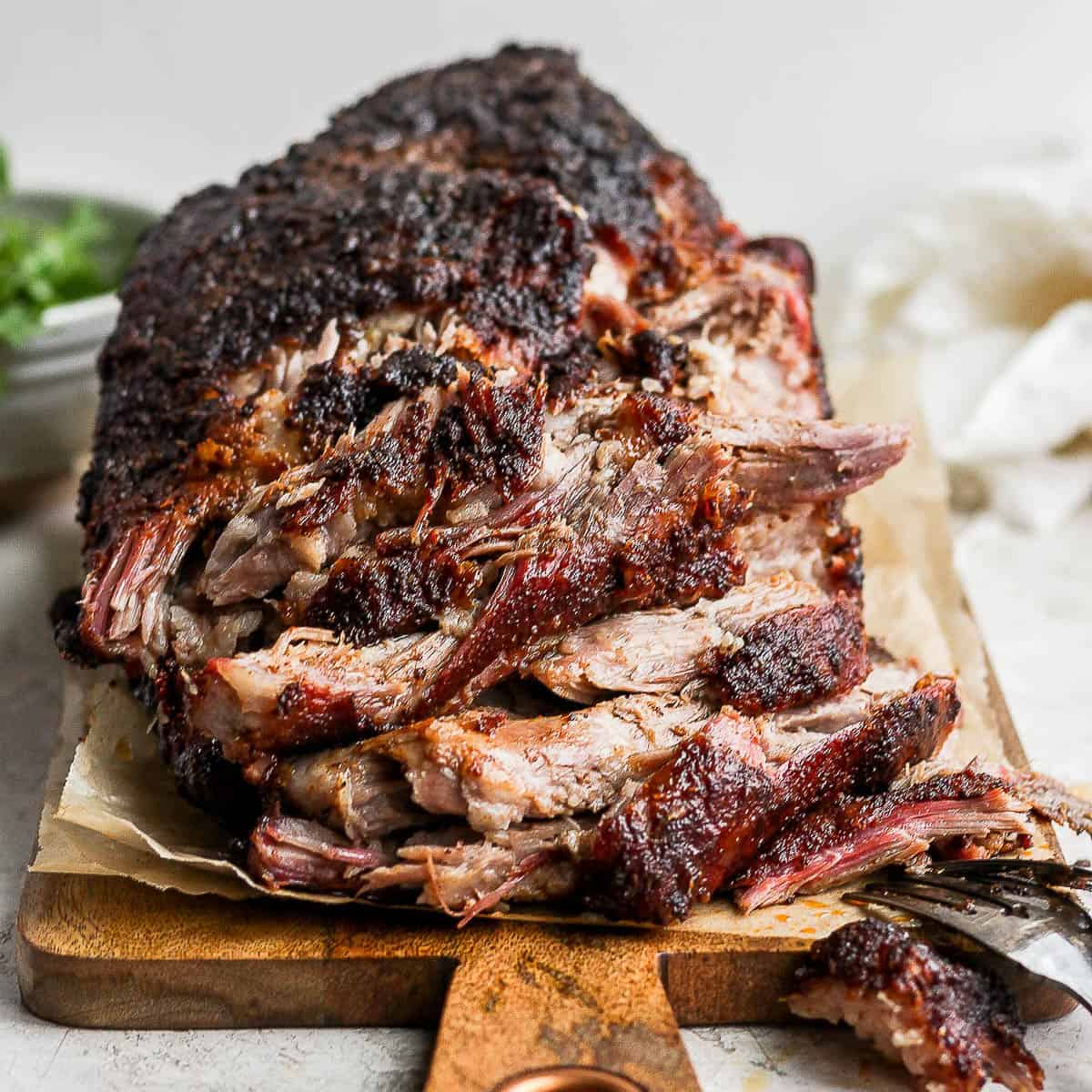
Smoking a pork shoulder requires proper preparation to ensure a flavorful and tender result. Here is a step-by-step guide on how to prepare the pork shoulder for your smoker:
1. Seasoning the Pork Shoulder: The first step is to create a delicious dry rub for the pork shoulder. Season it generously with your preferred spices, herbs, and seasonings. Let the meat sit in the rub for at least twelve hours or overnight to allow the flavors to penetrate the meat.
2. Preheating the Smoker: While the pork shoulder is marinating, preheat your smoker to a temperature between 180 and 225F. This low and slow cooking method will allow the connective tissues in the meat to break down slowly, resulting in juicy and tender meat.
3. Placing the Pork Shoulder in the Smoker: Once your smoker has reached the desired temperature, place the seasoned pork shoulder inside. If you have a boneless pork shoulder, it will take approximately one hour and thirty minutes per pound to cook thoroughly. For bone-in shoulders, calculate two hours per pound.
4. Wrapping the Pork Shoulder: When at least two-thirds of the cooking process has passed, it’s time to wrap the pork shoulder with either aluminum foil or kraft paper. This wrapping process helps retain moisture and protects the meat from drying out during cooking.
5. Allowing Resting Time: Once cooked, remove the wrapped pork shoulder from the smoker when its internal temperature reaches 195F. However, keep in mind that residual heat will cause an increase of five to ten degrees after removing it from heat. Allow it to rest inside its wrap for at least two hours before serving.
6. Shredding and Serving: After resting, unwrap the pork shoulder and use forks or shredding claws to pull apart the meat. The result will be tender and juicy pulled pork that can be used in various dishes such as burgers, tacos, sandwiches, and more.
Following these steps will ensure a perfectly prepared pork shoulder for your smoker. Remember to monitor the temperature throughout the cooking process and experiment with different rubs and seasonings to find your preferred flavor profile. Enjoy the delicious results!
TOP TIPS TO ACHIEVE THE JUICIEST PORK SHOULDER
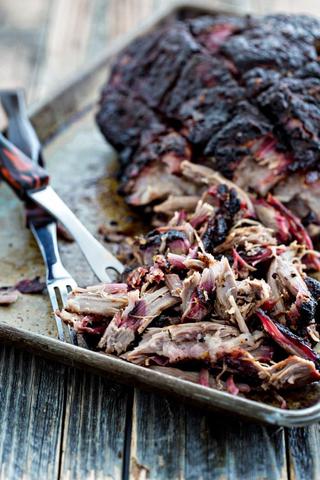
1. Use the right wood: Choose wood chips like hickory or oak to enhance the flavor of your smoked pork butt.
2. Serve with complimentary sides: Pair your smoked pork shoulder with delicious sides like roasted vegetables, mac and cheese, or salad to elevate the overall taste.
3. Monitor the temperature: Invest in a thermometer gun to ensure you cook the meat at the right temperature for perfect tenderness.
4. Let it rest: After removing the pork shoulder from the smoker, let it rest for at least two hours to allow the juices to redistribute and make the meat even more tender.
5. Shred properly: Use a fork or shredding claw to shred the meat into desired pieces before serving.
By following these tips, you can achieve a juicy and flavorful pork shoulder that will be a hit at any gathering.
USE THE RIGHT WOOD
Choosing the right type of wood is crucial for enhancing the flavor of your smoked pork butt. Some popular options include hickory, oak, and fruit woods like apple or cherry. The type of wood you choose will depend on your personal preference and the flavor profile you want to achieve.
To elevate the taste of your smoked pork butt even further, consider serving it with delicious sides. Roasted vegetables, cheese casserole, sweet potato dishes, salads, mac and cheese are just a few examples of sides that pair well with this flavorful meat. The combination of the smoky pork and complementary sides will create a complete and satisfying meal.
Investing in a thermometer gun is essential for achieving perfectly cooked pork butt. Keep a close eye on the temperature throughout the cooking process to ensure that it reaches the desired level of tenderness. Accurate temperature readings will help you adjust cooking times and make any necessary adjustments to achieve optimal results.
By following these tips and techniques for wrapping and preparing pork butt, you can create a juicy, tender, and flavorful dish that will be a hit at any gathering or dinner party. Remember to customize the process based on your preferences and check the temperature regularly to ensure perfection in every bite.
SERVE IT WITH SOME DELICIOUS SIDES
When serving your perfectly cooked pork butt, it’s important to pair it with delicious sides that complement the flavors of the meat. Consider serving it with roasted vegetables, such as carrots, Brussels sprouts, or sweet potatoes, to add a healthy and flavorful element to your meal. Another great option is a cheesy casserole, like mac and cheese or scalloped potatoes, which will provide a creamy and indulgent side dish. You can also serve the pork butt with a fresh green salad or coleslaw for some added crunch and freshness. Whatever sides you choose, they will enhance the taste of the smoked pork butt and create a complete and satisfying meal.
To ensure that your pork butt is perfectly cooked, it’s crucial to monitor the temperature throughout the cooking process. Investing in a reliable thermometer gun will help you accurately measure the internal temperature of the meat. This will allow you to make any necessary adjustments and ensure that the meat reaches the desired level of tenderness. By keeping an eye on the temperature, you can achieve juicy and flavorful results every time you cook a pork butt.
Choosing the right wood for smoking your pork butt can greatly enhance its flavor profile. Some popular options include hickory, oak, applewood, or cherry wood. Each type of wood imparts its own unique flavor to the meat. Experimenting with different woods can help you discover your personal preference and create a customized taste experience. Whether you prefer a smoky and robust flavor or something more subtle and fruity, selecting the right wood is key to achieving delicious results.
Remember these tips when preparing and cooking your pork butt for an unforgettable dining experience. With proper wrapping techniques, accurate temperature monitoring, flavorful wood selection, and delicious side dishes, you can create a meal that will impress your family and friends. Enjoy the process of cooking this juicy and tender meat, and savor every bite of your perfectly smoked pork butt.
KEEP CHECKING THE TEMPERATURE
During the cooking process, it is crucial to keep a close eye on the temperature of the pork shoulder. Using a thermometer gun, regularly check the internal temperature to ensure that it reaches the desired level of doneness. This will help you avoid undercooking or overcooking the meat, resulting in perfectly tender and juicy pulled pork.
Knowing when to wrap the pork shoulder is essential for achieving optimal texture and flavor. As a general guideline, wrap the pork shoulder when it reaches a temperature between 155 and 170F and when the bark is cooked to your liking. However, factors such as size and cooking method can affect this timing, so rely on temperature and bark appearance rather than rigidly following a recipe.
Unwrapping the pork shoulder should be done carefully to ensure that all the juices are retained. Once the meat reaches an internal temperature of 190-195F, remove it from the smoker but allow it to rest in its wrap for at least two hours. This resting period allows the meat to reabsorb its juices, resulting in a more tender and flavorful end product.
FINAL WORDS
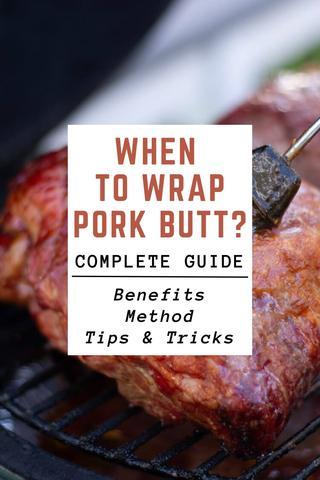
In conclusion, knowing when and how to wrap a pork butt is essential for achieving the perfect flavor and texture. Wrapping the meat during the cooking process helps manage the stall and retain moisture, resulting in juicy and tender meat. Whether you choose to wrap it in aluminum foil or kraft paper, make sure to do so when two-thirds of the cooking process has passed. Additionally, letting the meat rest after cooking allows the juices to be absorbed back into the fibers, enhancing its tenderness. By following these guidelines and keeping an eye on the temperature, you can create a delicious and satisfying dish that will impress your friends and family.
In conclusion, when it comes to wrapping a pork butt, the ideal temperature will depend on your desired cooking method. If you want to speed up the process and ensure tender meat, wrap it in foil at around 160-165°F. However, if you prefer a crispier bark, skip the wrapping altogether. Experiment with different temperatures to achieve the perfect result that suits your taste preferences.
Learn More About Grilling
If you want to learn more about grilling, check out these other helpful resources!


